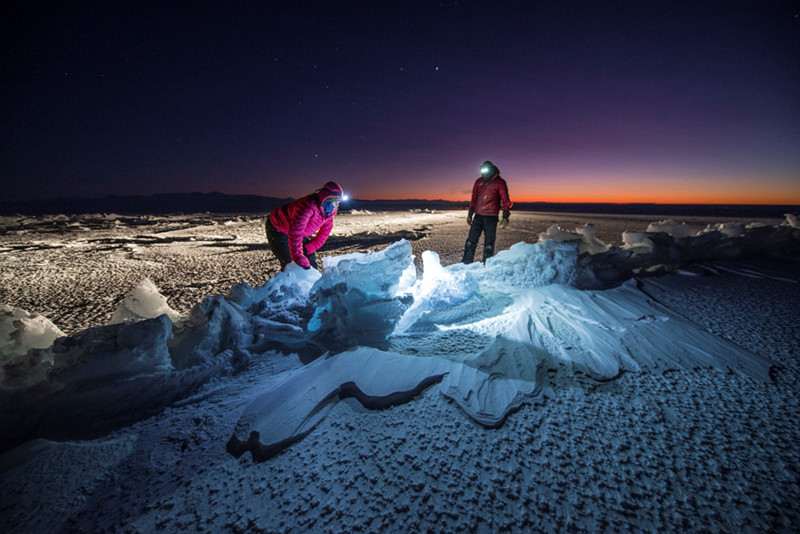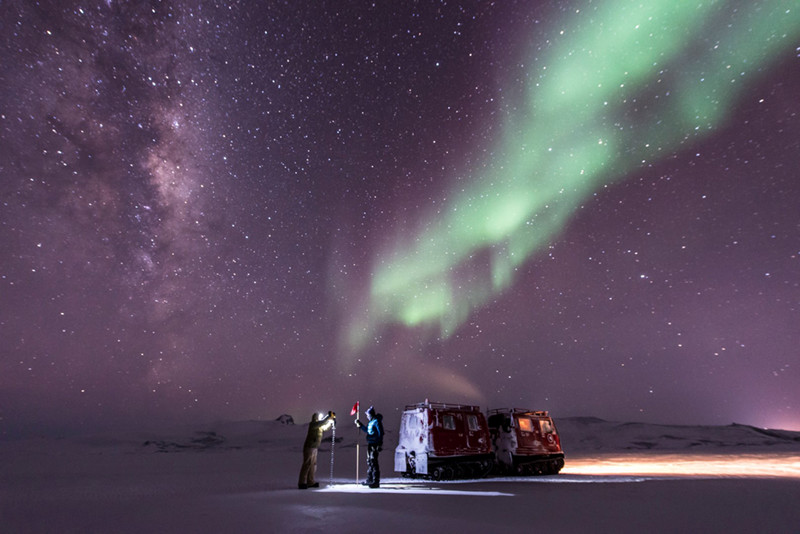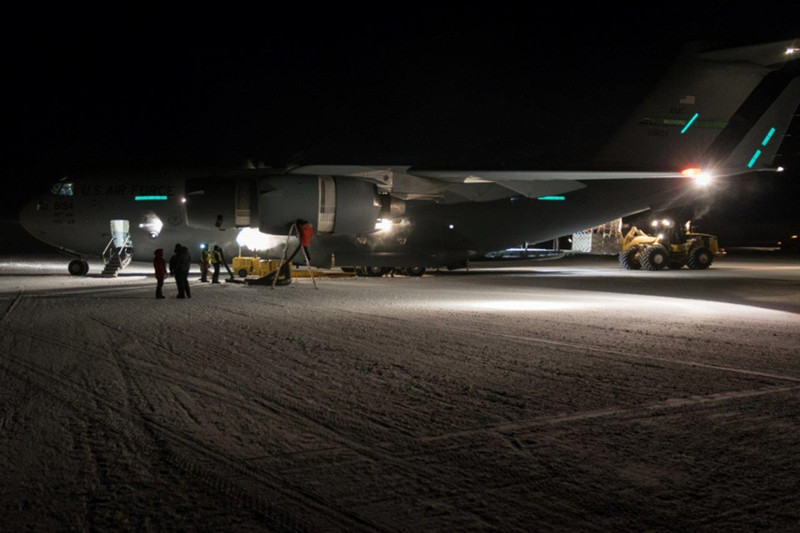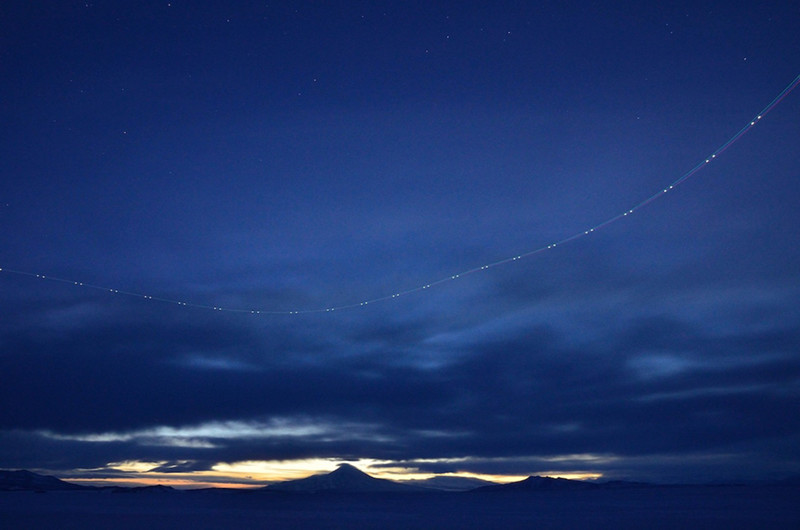
Photo Credit: Alasdair Turner
|
In the Antarctic twilight, two members of the sea ice team inspect a crack in the sea ice. With the new, major
changes to the long-standing Winfly schedule, they’re able to start work much earlier in the year.
|
The Last Winfly
By Michael Lucibella, Antarctic Sun Editor
Posted September 21, 2016
McMurdo Station is gearing up for the busy austral summer season as this year’s Winfly gets underway.

Photo Credit: Rebekah Osgood
Scientists and support staff disembark from an Airbus A319 at Pegasus airfield. During the week of Winfly, the station population nearly doubles from its winter low.
Since 1967, Winfly has been the transition period between the winter and summer seasons. It’s when a quick succession of planes deliver a host of new people to the station in early August, followed by no additional flights for about two months. It allowed the newly delivered support staff enough time to prepare the station before the majority of researchers and workers begin to arrive in early October for “mainbody.”
However next year, as the station starts to transition into year-round science operations, flights will be flying to and from the station roughly once a month throughout the winter, negating the need for that early cluster of flights.
Right now, workers are in the process of digging out vehicles and equipment, opening facilities that had been shuttered over the winter and getting station operations ready for the multitude of people soon to arrive.
“The station is bustling right now,” said Pedro Salom, the winter site manager for the station. “The increased activity started at the beginning of August, with a focus on de-winterizing buildings, vehicles and equipment, prepping the runway for the Winfly flight period and preparing for the influx of two Winfly science groups.”
The formerly dark skies overhead had been brightening until the sun rose over the horizon on August 20 for the first time in four months. With the first rays of the sun, came an influx of new faces to the station. Five flights arriving at the station over the last week of August more than doubled the station’s population. McMurdo Station is now home to 326 people, up from about 150 for most of the winter.

Photo Credit: Alasdair Turner
Members of the sea ice team measure the thickness of the sea ice and mark off a safe route with a flag.
For residents who stayed through all four months of darkness, Winfly means dramatic changes in life on the station.
“It’s also a bittersweet time for many of who have been here for the winter,” Salom said.
“We have the return of the sun and an influx of new energy, but we say goodbye to good friends departing at Winfly and have to adjust to new workplace and social dynamics.”
Most resided at the station for all four months of winter, while a few arrived later in the season. This is because the new winter flights operated by the U.S. Air Force’s 446th and 62nd Airlift Wings have been more integrated into the program after last year’s test runs and before next year’s planned sustained monthly flights.
This past austral winter, the number of people flying in and out of McMurdo during the months of June and July tripled to 117 over 39 last year. In addition, the flights delivered more than 100,000 pounds of supplies to the station over the same period. Before last year, there were no routine flights in or out between April and August.
“This came with several challenges in terms of accommodating such large turnover of personnel, but many of the people arriving on station were veterans which eased the transition,” Salom said.

Photo Credit: Rebekah Osgood
For the second year in a row, scheduled flights during the dark of winter brought people to and from McMurdo Station. Next year, these flights should be arriving about once a month throughout winter, eliminating the need for a busy Winfly.
These winter flights helped the support staff get a head start preparing the station for the early arriving science groups. One of the people who flew in during winter was Alasdair Turner who is in charge of assessing the safety of the frozen sea ice before heavy machinery and science groups are allowed on it.
“We have been lucky this year,” Turner said. “The sea ice set up under calm ocean conditions which create a smoother surface. This allows us to do a lot less driving around to avoid un-drivable areas.”
Over the winter, the ocean surface around McMurdo Station freezes. The ice, which is up to several feet thick, is strong enough for vehicles to drive on and temporary structures to be erected. However cracks do form, and part of Turner’s job is to map where cracks are and lay out safe ice routes avoiding those hazards.
In previous years, the safety teams have at times deployed on some of the same flights as the first scientists. That has delayed the starts of the researchers’ projects until after the sea ice team’s work is finished. Sending Turner and other safety team members down during the winter gave Winfly researchers a boost.
“The most notable benefit is the ice is ready for Winfly [science] groups to access as soon as they arrive,” said Meghan Walker, the field manager for McMurdo science projects in Antarctica. “Starting our sea ice work in July, before the grantees arrive and before the ice needs to be operational allows us the lead time to conduct proper route finding and establish the conditions of the annual ice.”

Photo Credit: John Cassano
In this time-lapse photo, researcher John Cassano flies an unmanned aerial system, known as the Small Unmanned Meteorological Observer, over Pegasus airfield in September 2012. He is back this year to continue taking meteorological measurements with the device.
Turner added also that being able to get out onto the sea ice while it’s still dark out is more efficient for him and his team.
“As we move toward year-round science operations, it is important that my job is done earlier in the season,” Turner said. “[With] the techniques we have developed for surveying and flagging the main sea ice routes in the dark, it has actually become easier to do our job in the winter season. As soon as the sun comes up, the weather tends to get worse. Winfly weather is notoriously bad. Winter work is much more efficient due to the relatively stable weather.”
One of the research teams taking advantage of the newly opened sea ice is Randall Davis’s seal research team from Texas A&M University. He and his team are taking advantage of the lingering darkness to investigate whether Weddell seals use the Earth’s magnetic field to navigate when there’s no light.
John Cassano at the University of Colorado, Boulder, is the lead researcher on another project already at the station. He and his team are flying small unmanned aerial vehicles around Pegasus White Ice Runway up to 5,000 feet to take early season meteorological measurements.
“The early deployment is important because it allows us to observe more winter-like conditions than we normally do during our mainbody trips,” Cassano said.
He added that though the population on station may have doubled in a week, the station is still running at just a fraction of its capacity.
“McMurdo is definitely more quiet than during the main summer season,” Cassano said. “This is my third Winfly and I really like the smaller station population and more intimate nature of the station at this time of year.”









